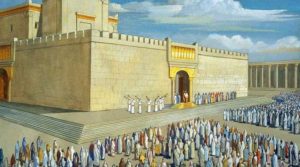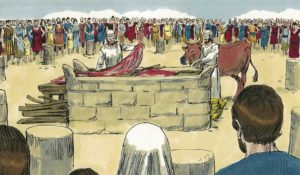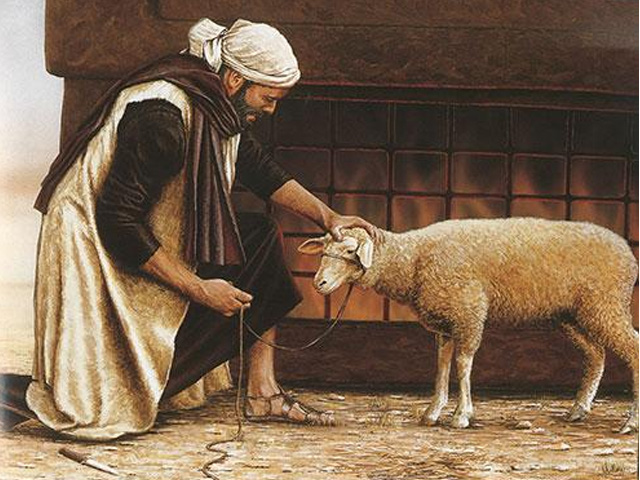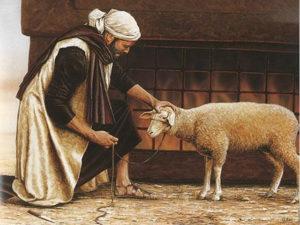Let’s Blame Odom (Adam)
Shoin, after months of klapping (banging) away and getting the Mishkan, the Mizbayach (Tabernacle and Altar) and all of the accoutrements built and ready to function properly, it’s time to keep the place humming. As we begin Vayikra (the book of Leviticus, so named by the Greeks), the RBSO provides a few hundred mitzvois and detailed instructions concerning the korbonois (offerings) in the Temple. Some call Vayikra Toiras Kohain because they, the kohanim, had the Mizbayach franchise and seemingly got a cut of almost every korban that came their way. In fact, says one Medrish: the RBSO instituted korbonois to give the otherwise unemployed Koihanim a parnoso. Shoin! How many times has the Oisvorfer told you how benevolent and merciful the RBSO is? Many! In kimat every parsha, through the mitzvois handed down, be they of the ah-says or loi’s, the RBSO also created jobs and industries mamish. Korbonois were no different and seemingly kept the koihanim quite occupied.
 Nu, just about now, efsher you’re klerring to yourselves azoy: why not skip over these chapters? Have you seen a Mizbayach anywhere and are people still bringing korbonois? Didn’t we lose the second Beis Hamikdash for bad behavior over 2000 years ago? Let’s instead get back to a few salacious stories about who did what, when and to whom. Ober Raboyseyee, it’s not so poshit and by the time you finish this week’s heylige Toirah, the seventh time mamish we are learning Sefer Vayikro, you will chap that though we no longer bring Korbonois and though the Oisvorfer has a hard time imagining korbonois when the Moshiach arrives, for now we have to chap that efsher there are lessons to be learned from them in our daily lives. What those are, ver veyst, but avada our rabbis have posited many theories. Moreover, since we cannot fulfill the mitzvah of bringing a korban through action, though avada action could lead one to bringing or necessitating a korban or two, if you chap, our studying of them, as we are doing right now, is their fulfillment. Shoin! Read the heylige Oisvorfer’s Toirah and receive a mitzvah or more; what could be more givaldig? Don’t answer that!
Nu, just about now, efsher you’re klerring to yourselves azoy: why not skip over these chapters? Have you seen a Mizbayach anywhere and are people still bringing korbonois? Didn’t we lose the second Beis Hamikdash for bad behavior over 2000 years ago? Let’s instead get back to a few salacious stories about who did what, when and to whom. Ober Raboyseyee, it’s not so poshit and by the time you finish this week’s heylige Toirah, the seventh time mamish we are learning Sefer Vayikro, you will chap that though we no longer bring Korbonois and though the Oisvorfer has a hard time imagining korbonois when the Moshiach arrives, for now we have to chap that efsher there are lessons to be learned from them in our daily lives. What those are, ver veyst, but avada our rabbis have posited many theories. Moreover, since we cannot fulfill the mitzvah of bringing a korban through action, though avada action could lead one to bringing or necessitating a korban or two, if you chap, our studying of them, as we are doing right now, is their fulfillment. Shoin! Read the heylige Oisvorfer’s Toirah and receive a mitzvah or more; what could be more givaldig? Don’t answer that!
As we begin Vayikra we are overwhelmed by the intricate detail with which the Toirah describes the procedures for bringing korbonois. As a result, we typically tune out, fall asleep, talk during laining, read some of the handouts that one fellow always seems to fill his talis bag with, stare at the ezras noshim (ladies section), skip shul altogether or make kiddush much earlier. Why? Because we can’t stand listening to this, even the koihanim are bored stiff. On the other hand, the Oisvorfer has some givaldige news for you: no matter how egregious your behavior, and hard as you may try, you can no longer violate all 613 mitzvois. Shoin. Let’s then begin Parshas and Sefer Vayikra which covers over 240 mitzvois which are Beis Hamikdash (Temple) related with some basic arithmetic. Avada you recall that the second Beis Hamikdash was destroyed over 2000 years ago. Many say we lost it as a result of sinas chinom, meaning people couldn’t stand each other for no good reason at all. And taka says the heylige Gemoro (Yoma 9b): “Why was the Second Beis Hamikdash destroyed? Because of sinas chinam, senseless hatred of one Jew for another.” And given that we are nebech still in golus (exile) without a Temple, roughly 244 of the temple related heylige Toirah’s mitzvois are now gone. Shoin and then there were but 369. Not much has changed; biderech klal, people still cannot stand one another. Who needs a reason?
Is it taka emes that the Taryag Mitzvois (613 of which 248 are do’s, and 365 don’ts) that we heard about every day in yeshiva are mamish no longer with us? Iz-dus-meyglich (is this possible)? Seemingly it is, or is it? Let’s go veyter and see. Moreover, there are others that pertain only in certain situations and when those are removed from the equation, we’re down to but 270 precepts that every Yid is required to observe, without any particular circumstance ever having to come about. And of those, 48 are positive precepts, and 222 are negative. Yet, despite the drastically reduced number of mitzvis, many of you still find ways to violate at least one daily? Oy vey! Included in the count of the lost mitzvis are all those that pertain to the korbonois (sacrifices) that are covered in the first weeks of Sefer Vayikra. Shoin!
 Nu, when it comes to accounting, the numbers don’t always match up and says the Shelah (Rabbi Isaiah Horowitz) azoy: of the 248 positive commands, only 126 currently apply. And of the 365 negative commands, only 243 are still in force. So in total, nowadays, 369 mitzvois are still operative. Using different math, he states that nowadays, there are 122 fewer positive mitzvois to observe (248-126=122), and also 122 fewer negative mitzvois to keep (365-243=122)! Shoin and 244 fewer it is. The Shelah notes that this number, 244, is the same as the numerical value for the Hebrew word, מרד, which means to rebel. And this avada alludes to the fact that it was because of the Yiddin’s rebelliousness that they were exiled from the land, and that the heylige Beis Hamikdash was destroyed. Nu, given our behavior bazman hazeh (in our times), especially when it comes to petty jealousies and sinas chinam, it’s hard to imagine the third Beis Hamikdash being built or even falling out of the sky, as theorized by others who pontificate on its rebuilding. It will be built how? Nu, it depends on which pshat you like. One view maintains that the future Beis HaMikdash will be built by the RBSO Himself (Shemois Rabbah 15:1; Tanchuma, Ki Sissa 13). Ober says Rashi, efsher the greatest of the classic commentators, azoy: the future Temple which avada we all eagerly await, stands in the heavens fully built and exquisitely decorated, and from there it will descend. The heylige Gemora (Rosh HaShanah 30a) endorses this view: “The future Temple is in the hands of Heaven.” When will it come, ver veyst? In the meantime, don’t give up your day job.
Nu, when it comes to accounting, the numbers don’t always match up and says the Shelah (Rabbi Isaiah Horowitz) azoy: of the 248 positive commands, only 126 currently apply. And of the 365 negative commands, only 243 are still in force. So in total, nowadays, 369 mitzvois are still operative. Using different math, he states that nowadays, there are 122 fewer positive mitzvois to observe (248-126=122), and also 122 fewer negative mitzvois to keep (365-243=122)! Shoin and 244 fewer it is. The Shelah notes that this number, 244, is the same as the numerical value for the Hebrew word, מרד, which means to rebel. And this avada alludes to the fact that it was because of the Yiddin’s rebelliousness that they were exiled from the land, and that the heylige Beis Hamikdash was destroyed. Nu, given our behavior bazman hazeh (in our times), especially when it comes to petty jealousies and sinas chinam, it’s hard to imagine the third Beis Hamikdash being built or even falling out of the sky, as theorized by others who pontificate on its rebuilding. It will be built how? Nu, it depends on which pshat you like. One view maintains that the future Beis HaMikdash will be built by the RBSO Himself (Shemois Rabbah 15:1; Tanchuma, Ki Sissa 13). Ober says Rashi, efsher the greatest of the classic commentators, azoy: the future Temple which avada we all eagerly await, stands in the heavens fully built and exquisitely decorated, and from there it will descend. The heylige Gemora (Rosh HaShanah 30a) endorses this view: “The future Temple is in the hands of Heaven.” When will it come, ver veyst? In the meantime, don’t give up your day job.
Ober before you go shouting from the rooftops that 613 is now a much smaller number and that ‘taryag’ is no longer operative, listen to this. Our Chachomim (wise rabbis) solved the problem of the diminished count by creating new ones to replace the lost ones. Shoin! Taka how? In mamish a brilliant move, they established something we call davening (prayers) and established the number of fixed, daily prayers to correspond to the number of regular, daily sacrifices that were offered while the Beis Hamikdash stood and was operative. In effect, they substituted davening for the korbonois and temple service. And says the medrish: when we chazir (review and study) the laws governing such precepts, on a spiritual level, we get credit as if we had actually performed them. And some say that even bazman hazeh (in our times), though we don’t sacrifice animals or birds as korbonois, by not capitulating to the demands of our “animal soul,” our base instincts, if you chap, we offer the “animal” within ourselves to the RBSO. Givaldig and gishmak mamish. Nu, lommer lernin a bissel parsha.
 Nu- let’s start with basics: what the hec is a korban and why do we need to know? Taka excellent kashas ober as you know the heylige Toirah doesn’t tell us anything we don’t need to know. Case closed, and who says you have to know or understand more? Do you chap how your radio or TV, fax machine, email and Internet work? Do you chap how your eishes chayil thinks? Zicher not!! In Vayikra, the RBSO told Moishe to tell the Yiddin all about korbonois with different rules governing each variety of korban.
Nu- let’s start with basics: what the hec is a korban and why do we need to know? Taka excellent kashas ober as you know the heylige Toirah doesn’t tell us anything we don’t need to know. Case closed, and who says you have to know or understand more? Do you chap how your radio or TV, fax machine, email and Internet work? Do you chap how your eishes chayil thinks? Zicher not!! In Vayikra, the RBSO told Moishe to tell the Yiddin all about korbonois with different rules governing each variety of korban.
A Korban then is the term for a variety of sacrificial offerings described and commanded in the heylige Toirah. Such sacrifices were offered in a variety of settings by the ancient Israelites (our forefathers and going all the way back to Kayin and Hevel- remember them?), and later by the Koihanim, at the Temple in Yerusholayim. Even our heylige Ovois, on certain occasions, spontaneously built an altar, and brought an offering to the RBSO. A Korban was usually but not always, an animal sacrifice, such as a sheep or a bull that underwent shechita (Jewish ritual slaughter), and was often cooked and eaten by the offerer, with parts given to the Koihain and parts burned on the Temple mizbayach. Korbonois could also consist of doves, grain, wine and incense. Ok are you sleeping yet? Here in Vayikra, the RBSO told Moishe all about these strange rituals ober didn’t really tell him why? We got the manual, the grizzly detailed instructions but were epes never told why we bring these. Says the RambaN: it’s one of the great secrets the RBSO did not share with us. And what do you suppose happened as a result? For centuries to come, beginning with the Reshoinim, our Sages and other luminaries have argued vehemently about ‘why’. Seemingly, a huge machloikes (dispute) arose between the RambaM and the RambaN and let’s see what the fuss is all about.
Says the RambaM azoy: korbonois were commanded as a response to the cultural trend, most prevalent in Egypt at that time, of ritually slaughtering animals. Seemingly, the Yiddin had become accustomed to this practice and would have had a very difficult time coping with a religion that did not offer sacrifices as a form of worship. The RBSO chapped all that, He chaps everything all the time, and commanded the Yiddin to bring animal offerings in order to curb their yetzer horoh (evil inclination). In theory then, by bringing a korban to the RBSO, the one and only true God, we demonstrate our firm rejection of these beliefs in other deities. In other words, the RBSO knew that the Yiddin were a bunch of fickle people who could easily fall prey to idol worship, which they did on more than one occasion during their 40 year stint in the Midbar, and created Korbonois to help the oisvorf Yiddin channel these desires. Channeling desires is avada better than acting out on them, if you chap. Then again, acting out on them and then bringing the korban ‘Chatos’ or ‘Oshom’ (the guilt or sinner sacrifice), is also not so giferlich. And isn’t that why the RBSO prescribed the Chatos and Oshom (both associated with some form of wrongdoing) offerings? Ver veyst. Nu, speaking of the Korban Oshom and Korban Chattos, listen to this givaldige chiddish (breakthrough chap). Seemingly, women too may bring certain of these particular Korbonois. Efsher you’re wondering what type of guilt or sin would the eishes chayil or other women have to commit in order to bring these offerings, are you? Nu, listen up because pshat is mamish givaldige news for the husbands: We are taught that the veyber (women) may taka bring a Korban Chatos and Oshom offerings in atonement for transgressions and unintentional errors. And just to prove that the medrish always has something pleasurable to share even if the woman of the house didn’t, if you chap, specific examples cited as cause for the bringing of the guilt and sin offering include such dastardly acts as: not taking care of the husband’s needs regularly, feigning headaches, and fakery, if you chap. Avada there are other examples, and efsher we’ll cover them next week.
Says the Abarbanel: the RambaM’s position is taka correct and anchored in Midrashic and Talmudic literature. Isn’t everything found there?
Ober say the RambaN: this makes no sense at all and sharply criticizes the RambaM’s theory. Says the RambaN about the RambaM’s theory on korbonois azoy: “These are nonsensical words, which offer healing offhand for a great wound and considerable difficulty.” What that means, the Oisvorfer doesn’t know but complimenting the RambaM he wasn’t. In other words: the RambaN lambasted the RambaM’s theory and how he rationalized korbonois. Instead, he offers a hypothesis of his own that spices things up somewhat. Halt kup (pay attention- it’s worth your time). Since the acts of man are comprised of thought, speech, and action, the RBSO commands that when an individual sins and brings an animal sacrifice, he should think about the following when he follows the order.
- a) the offerer should rest his/her hands upon its (the korban’s) head—corresponding to the sinful action that precipitated this expiation;
- b) the offerer should confess what he/she did wrong—thereby atoning for the speech that contributed to the transgression;
- c) the offerer should recognize that the innards and kidneys being burnt in the altar’s fire represent the need for atonement on the part of all human thought and passion;
- d) the burning of the animal’s limbs corresponds to the need for atonement for the hands and feet of the sinning individual since these limbs carry out all of his/her sinful activity;
- e) the casting of the sacrifice’s blood upon the altar should bring the phrase to mind, ‘his blood will be on his soul.’
A person, by either doing or watching all of these actions, will come to realize that he/she has sinned against the RBSO with his/her body and or soul, and that he/she deserves that their own blood to be applied to his/her body and be burned. And had it not been for the compassion of the RBSO, who in His benevolence has accepted a substitute, they would be goners. Shoin!
 Ok that was a mouthful, what did he really mean? Let’s chazzir (review): Says the RambaN azoy: The whole point of the korban is that a person (like yourself by way of a good example) should feel that everything done to the animal being sacrificed should really be done to the sinner (lemoshol, you). He should feel as if his blood should be spilled and his limbs should be burned, but the RBSO, in His ultimate mercy, agrees to accept the animal as a substitute. Nu, is this a great system or what? Chazerrim like yourselves can taka sin with every limb of your bodies and nebech the innocent animal who didn’t lust for his friend’s wife and zicher didn’t have forbidden relations with her, is nebech slaughtered at the altar. Nu, and now you can appreciate why the RBSO created animals in the first place.
Ok that was a mouthful, what did he really mean? Let’s chazzir (review): Says the RambaN azoy: The whole point of the korban is that a person (like yourself by way of a good example) should feel that everything done to the animal being sacrificed should really be done to the sinner (lemoshol, you). He should feel as if his blood should be spilled and his limbs should be burned, but the RBSO, in His ultimate mercy, agrees to accept the animal as a substitute. Nu, is this a great system or what? Chazerrim like yourselves can taka sin with every limb of your bodies and nebech the innocent animal who didn’t lust for his friend’s wife and zicher didn’t have forbidden relations with her, is nebech slaughtered at the altar. Nu, and now you can appreciate why the RBSO created animals in the first place.
Many commentators agree with the RambaN and note that one is supposed to realize that really he should be the one getting slaughtered during the services. This would cause one to have fear in Hashem which would eventually lead to teshuva (repentance). Therefore, we were forgiven for our sins through the korbonois.
This is also a deeper meaning of the word Korban, usually translated as sacrifice or offering. Korban comes from the word Karov, close. To come close to Hashem we have to elevate our animal nature to a G-dly nature. Efsher we can kler that the sacrifices we bring allow us -in close call style- to get away with our ungodly behavior.
Some say that the Korbonois system was created so that sinners who had to bring a Korban would feel the pinch in their pockets. Unfortunately, it was some other pinching in their pockets that got them into trouble to begin with, if you chap. Avada it’s well known that the imposition of fines and penalties is supposed to deter sinning. The sinner will realize that his wayward ways are getting too costly and get back on the right path. And for this reason, wealthy sinners had to bring a more expensive korban while the schlepper sinners got away with a lesser korban. In other words: a poor sinner could commit bigger sins and pay less: givaldig!
Why do we need to learn all about korbonois? Ver veyst. Ober the emes is that korbonois mamish follow where Sefer Shmois left off. For the greater part of that Sefer, Moishe was exhorting Paroy to let the Yiddin leave his country. Moishe kept hammering away the RBSO s message: “Release My people and they will serve Me”. Shoin, finally they were free and we are about to find out that serve Me meant through korbonois, animal sacrifices in the Beis Hamikdash.
And says the RambaM (Moireh Nevuchim 3:46) this bombshell: since animal sacrifices are no longer a feature of daily religious worship in most of the world, it is conceivable to suggest that the RBSO will do away with korbonois when the Moshiach arrives. OMG!
Nu, you can only imagine how well that went over with the koihanim who saw this as a threat to their entire future business opportunity in the messianic age. In fact, many koihanim feel that they are preparing for the arrival of Moshiach by learning the halochos (laws) of the avoidah (temple service) in the Beis Hamikdash so that they will be ready for resumption of their priestly duties in the Third Temple. Of course nobody is really sure whether all of the sacrifices will resume, just a few, or none of them. Others, including the RambaN (Vayikra 1:9) weren’t too happy either and disagree with the RambaM’s hypothesis vehemently. Says he, korbonois can atone for our sins.
The bottom line: why we bring korbonois, ver really veyst? Ober says the Shelah Hakodosh, efsher based on the very first posik of the parsha which states “Odom ki Yakriv Mikem…” (When an adam/man brings a sacrifice offering), azoy: the word ‘Odom’ in the posik refers specifically to man. Which man? Odom Horishoin. It’s all his fault! Pshat may, according to him, efsher be azoy: “know, that if Odom Horishoin (Adam) had not sinned (by eating of the forbidden fruit, a sin since emulated daily by millions of men all over the world, if you chap, which they do), there would have been no need for a separate holy place (the Mishkan), since the entire world would have been Gan Eden (Paradise).” His one sin, the original sin as we know it, is the root cause of the world’s order being rearranged. Wait, there’s more: “Likewise, if Odom had not sinned, there would be no need for some people (the koihanim) to be distinguished from the others, to serve Hashem (the RBSO). Rather, everyone would have been part of the “Kingdom of koihanim and a holy nation” as described with those exact words in the heylige Toirah (Shemois 19:6).” And a bit more” In that world (now long gone), man would not need to offer an offering to Hashem for man himself would have been an offering, just as we are taught that man’s soul is offered on the altar above after his death. Well, blow me down!
A gittin Shabbis
Yitz Grossman
The Oisvorfer Ruv

